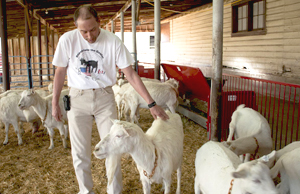
A Utah State University researcher is using dairy goats to grow safer airbags for the auto industry in a project using a material unchanged for millions of years.
Randy Lewis has a flock of 34 goats carrying the same two key genes that allow a spider to weave silk inserted into their genetic code. The result: goats that produce milk containing spider-silk proteins.

The professor believes the silk drawn from the goats’ milk could make airbags safer, because bags used now are made from materials that can knock children and adults back into their seats when deployed, sometimes causing injury.
Lewis says spider silk absorbs energy better, so airbags made with the fiber would minimize the knock-back effect.
“We think that this type of material could help reduce injuries from the airbags and still protect people very effectively,” Lewis tells Ward’s.
Lewis and his team are working to spin the proteins extracted from the milk into fibers with many potential applications.
Orb-web-weaving spiders produce six different kinds of silk. The fibers’mechanical properties are so effective they have changed little over millions of years.
But the researchers turned to goats because leaving production to the spiders takes too long.
Lewis, a professor of biology at USU’s College of Science, says the secret to producing large amounts of spider silk is to use “factories” designed to manufacture spider-silk proteins that are efficient and easily scalable.
The goats are his preferred spider-silk factories, because farming spiders has an unavoidable downside.
“Scientists have known since the late 1800s that farming spiders isn’t possible – spiders tend to eat other spiders within the vicinity,” Lewis says. “They are cannibalistic and territorial. There is no way to collect spider silk in a commercial way.”
In addition, he says, “To raise spiders and harvest the web isn’t feasible, because the different types of silk in the web will be different from the one type you want.”
Of the six varieties of silk a spider uses to construct a web, the strongest is used for the outer circles. The spiders also use that type to rappel to the ground.
Lewis, a molecular biologist, has spent more than two decades studying the proteins that allow spiders to spin strong, stretchy silk.
His team thus far has managed to spin a fiber similar to the spider's suspension line, but there is no sign of an artificial version of the silk on the horizon.
“Due to the complexity of the proteins in spider silk, I suspect that it will not be possible in the near future to make anything that compares to it,” Lewis says.
The spider silk not only could be used in airbags but also in tire cords; artificial ligaments, tendons and bone-repair materials; parachute cords and fabric; protective clothing; and in sports clothing and equipment, he says.
The goats are farmed in two groups, with the animals in each group carrying one of the two proteins needed to make the silk. The proteins are extracted from the goats’ milk, combined in a solution and placed in a syringe.
Because a spider draws its silk out of its spinners, the researchers do the same thing and pull the silk from the syringe.
“They pull it out like floss, not push it out like toothpaste,” Lewis says.
If the researchers can produce a fiber that’s effective in airbags, goats probably won’t be the best production method, however.
“Instead, we will use plants like alfalfa or cotton seed or silkworms,” Lewis says.
“We have produced silkworms that can make a combination of their silk proteins and spider-silk proteins in their cocoons. That silk is not as strong as the spider silk, but is substantially stronger than natural silkworm silk.”
Lewis is a member of the Utah Science Technology and Research’s Synthetic Bio-Manufacturing Center team. USTAR is a state-funded program that invests in research focused on innovation and commercial potential.



